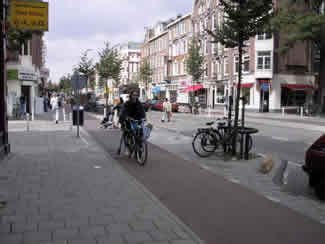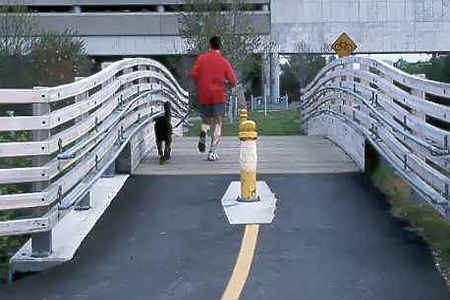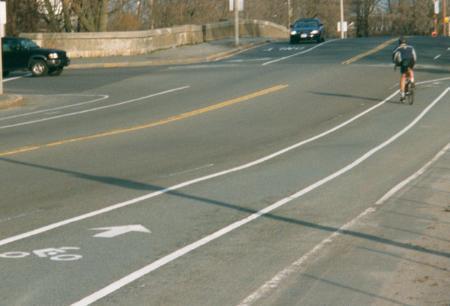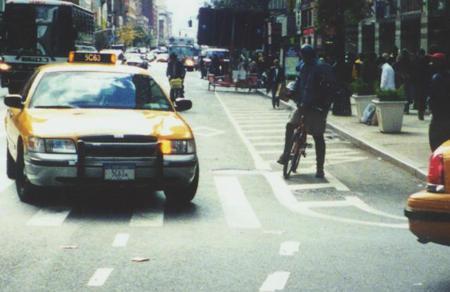Many people believe that the construction of special bicycle facilities is necessary to increase bicycle safety and to encourage more cycling. However, bikeways can make bicycle transportation more dangerous and less convenient insofar as they discourage bicyclists and motorists from following the rules of the road for drivers of vehicles.
There are three types of bikeways:
sidepath: a path adjacent to the roadway but separated from it by a physical barrier.
bike path: a path that is not adjacent to a roadway, but is in its own right-of-way, such as a former railway line.
bike lane: a traffic lane on a roadway marked for bicycle use only, and separated from the rest of the roadway only by markings.
Bicycle Sidepaths

A sidepath is a designated path for bicycles that runs next to a roadway. In some places, laws may require bicyclists to use this sidepath instead of the road. Sidepaths are essentially a marked section of the sidewalk. They can pose hazards for both pedestrians and cyclists. For instance, pedestrians with strollers may cross the path. On-street parking can also block the path.
At intersections, sidepaths present the same dangers as riding on a sidewalk. When a sidepath is designed for two-way traffic, half of the riders are traveling against the flow of traffic. This puts them at an especially high risk. A possible solution is to use special traffic signal phases for cyclists. However, this often requires cyclists to wait longer. This can lead to a greater chance of cyclists ignoring the signals.
Laws and Safety Studies
In the past, some cities designated sidewalks as bikeways. Today, these signs have largely been removed due to efforts by cyclists. Many mandatory sidepath laws have also been repealed. Despite this, some states still have such laws in place.
Numerous studies show that cyclists on sidepaths or sidewalks are at a higher risk of accidents. This risk is several times greater than for cyclists using the main roadway.
Bicycle Paths

Bike paths are not adjacent to a roadway. They often follow old railway lines, rivers, or run through parks. These paths can be useful for transportation, especially when they provide a shortcut around a barrier with no road alternative. However, they should always be seen as a supplement to, not a replacement for, using the roadway system. Bike paths can contribute to the public perception that cyclists should only use special facilities and not the main roads.
Risks and Safety Issues
The risk of injury for cyclists is actually higher on paths than on roads. This is due to several factors:
- Mixing of Users: Paths are used by bicyclists, pedestrians, children, skaters, dogs, and sometimes horses. This mix of users creates a hazard, as pedestrians can stop or turn instantly. Most bicyclists do not reduce their speed to a walking pace, which is often necessary to safely navigate this environment.
- Poor Construction and Maintenance: Paths may not be maintained as well as roads and can have surface hazards. Designers sometimes include features like railings or bollards to deter motor traffic. These can also be a collision risk for cyclists.
- Difficult Intersections: Crossing a road from a path can be difficult. The sightlines may be poor, and cyclists are almost always required to stop. They often face a stop or yield sign. However, the path crossing may be marked with a crosswalk, which can be confusing. A crosswalk indicates a right-of-way for pedestrians, but this may not apply to cyclists.
Bicycle Lanes


Special lanes for bicyclists can cause issues by encouraging both cyclists and motorists to disregard traffic rules. A bike lane that extends to an intersection can be confusing. Motorists turning right may stay in the left lane. This violates the rule that right turns should be made from the lane closest to the curb. Similarly, bicyclists going straight or turning left may be encouraged to stay on the right.
In some cases, bike lanes may even require bicyclists to break normal traffic rules. For example, a bike lane intended for straight-through travel may be on the left side of a left-turn-only lane. This can be unsafe.
Minimizing Confusion
Bike lanes cause fewer problems on roads with no on-street parking or intersections. In these cases, the lane is essentially a shoulder. Operational problems can be lessened by ensuring that bike lanes:
- Serve only one direction of traffic.
- They are located next to general traffic lanes with no barrier.
- They are not next to on-street parking unless there is enough space to avoid doors.
- They are removed before an intersection to allow for merging.
- They are not used in roundabouts.
Calling a shoulder a “bike lane” can also confuse. This may create the perception that the shoulder is the only place for a bicycle. This can be mitigated by removing any legal obligation to use the lane. It can also be done by informing the public that cyclists are not required to use the lanes.
Mandatory Use and Safety Studies
In many countries, as well as several U.S. states, bicycle lane use is mandatory. However, some of these laws have exceptions. The specific legal definition of a “roadway” can be important. In some places, a bike lane is part of the roadway, which can increase restrictions on cyclists.
Studies have shown that motorists give cyclists slightly less space when passing them in a bike lane. Cyclists also tend to ride in the middle of a bike lane next to parked cars, which puts them at risk of being hit by opening doors. No studies have definitively shown that bike lanes improve safety.